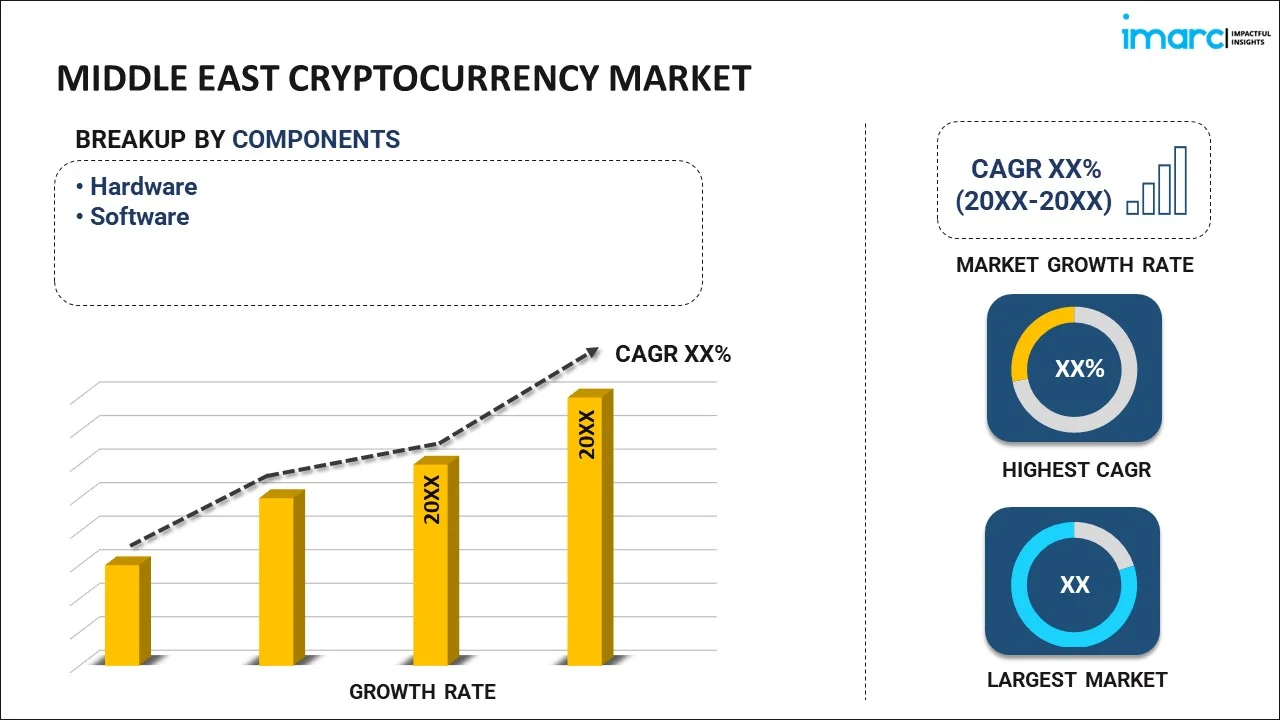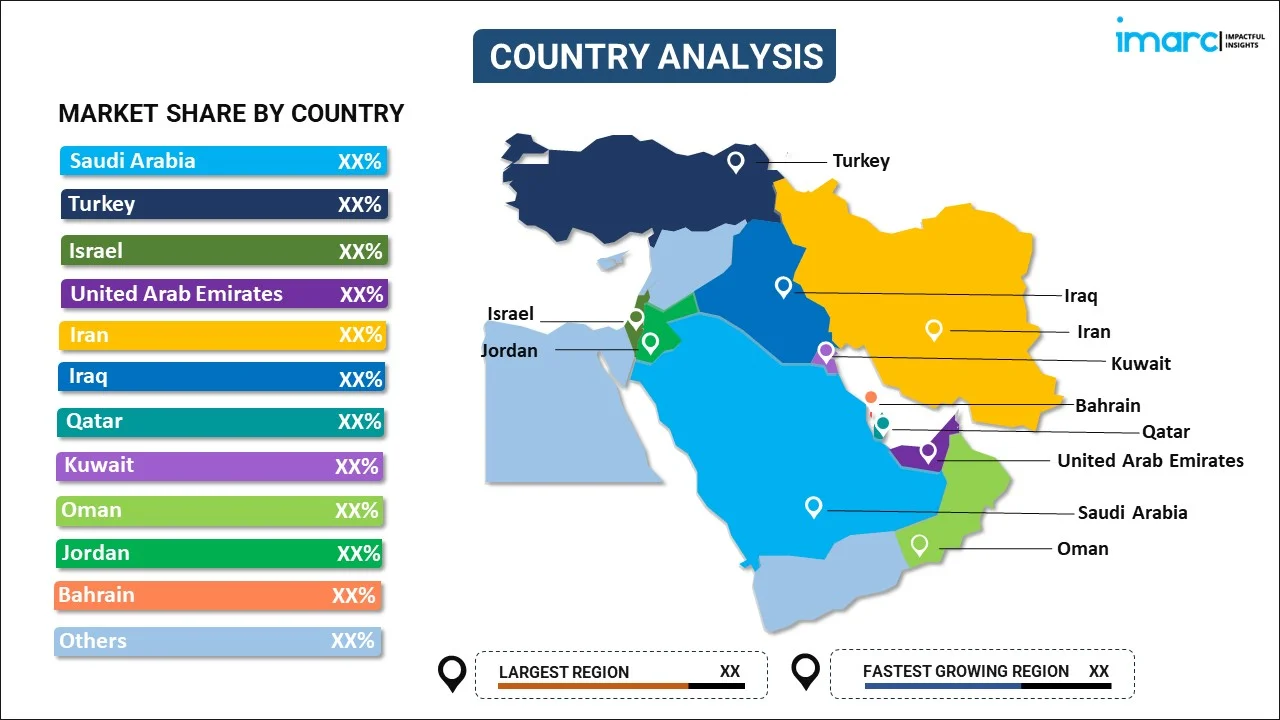
Middle East Cryptocurrency Market Report by Component (Hardware, Software), Type (Bitcoin, Ethereum, Bitcoin Cash, Ripple, Litecoin, Dashcoin, and Others), Process (Mining, Transaction), Application (Trading, Remittance, Payment, and Others), and Country 2025-2033
Market Overview:
Middle East cryptocurrency market size reached USD 1,10,275.0 Million in 2024. Looking forward, IMARC Group expects the market to reach USD 2,34,336.0 Million by 2033, exhibiting a growth rate (CAGR) of 8.74% during 2025-2033. The market is experiencing growth due to increasing recognition of digital assets as a feasible investment category and the growing willingness to adopt online payments for improved convenience.
|
Report Attribute
|
Key Statistics
|
|---|---|
|
Base Year
|
2024
|
|
Forecast Years
|
2025-2033
|
|
Historical Years
|
2019-2024
|
| Market Size in 2024 | USD 1,10,275.0 Million |
| Market Forecast in 2033 | USD 2,34,336.0 Million |
| Market Growth Rate 2025-2033 | 8.74% |
Cryptocurrency is a form of digital or virtual currency secured through cryptographic techniques. Unlike traditional currencies issued by governments and central banks, it operates on decentralized networks utilizing blockchain technology. The use of cryptography ensures the security and reliability of transactions, preventing double-spending and ensuring transparency. Cryptocurrency facilitates faster and more cost-effective cross-border transactions, reducing the need for intermediaries. Its rising demand is attributed to its ability to provide financial services to unbanked population.
Middle East Cryptocurrency Market Trends:
The Middle East cryptocurrency market is witnessing significant developments, propelled by a convergence of factors that are reshaping the financial landscape in the region. As awareness about digital assets as a viable investment class grows, the Middle East is embracing the transformative potential of cryptocurrencies. Additionally, the increased acceptance of online payments, driven by the allure of enhanced convenience, is fostering a conducive environment for the adoption of digital currencies. Besides this, the emergence of blockchain technology, the underlying foundation of cryptocurrencies, has garnered particular attention in the Middle East, with its decentralized and secure nature appealing to a region that values innovation and efficiency. Cryptocurrencies, operating on decentralized networks and providing an alternative to traditional government-issued currencies, offer heightened security and transparency in transactions. This decentralized nature reduces reliance on intermediaries, making cross-border transactions faster and more cost-effective. As the Middle East continues to position itself as a hub for technological innovation, the cryptocurrency market is becoming an integral part of the financial landscape. The demand for cryptocurrency is not only fueled by investment opportunities but also by its potential to provide financial services to segments of the population that are unbanked or underbanked. Governments and financial institutions in the Middle East are increasingly exploring the regulatory frameworks needed to navigate the cryptocurrency landscape, signaling a recognition of its growing influence and potential contributions to the region's evolving financial ecosystem. This, in turn, is anticipated to fuel the regional market over the forecasted period.
Middle East Cryptocurrency Market Segmentation:
IMARC Group provides an analysis of the key trends in each segment of the market, along with forecasts at the regional and country levels for 2025-2033. Our report has categorized the market based on component, type, process, and application.
Component Insights:

- Hardware
- Software
The report has provided a detailed breakup and analysis of the market based on the component. This includes hardware and software.
Type Insights:
- Bitcoin
- Ethereum
- Bitcoin Cash
- Ripple
- Litecoin
- Dashcoin
- Others
A detailed breakup and analysis of the market based on the type have also been provided in the report. This includes bitcoin, ethereum, bitcoin cash, ripple, litecoin, dashcoin, and others.
Process Insights:
- Mining
- Transaction
The report has provided a detailed breakup and analysis of the market based on the process. This includes mining and transaction.
Application Insights:
- Trading
- Remittance
- Payment
- Others
A detailed breakup and analysis of the market based on the application have also been provided in the report. This includes trading, remittance, payment, and others.
Country Insights:

- Saudi Arabia
- Turkey
- Israel
- United Arab Emirates
- Iran
- Iraq
- Qatar
- Kuwait
- Oman
- Jordan
- Bahrain
- Others
The report has also provided a comprehensive analysis of all the major regional markets, which include Saudi Arabia, Turkey, Israel, United Arab Emirates, Iran, Iraq, Qatar, Kuwait, Oman, Jordan, Bahrain, and Others.
Competitive Landscape:
The market research report has also provided a comprehensive analysis of the competitive landscape in the market. Competitive analysis such as market structure, key player positioning, top winning strategies, competitive dashboard, and company evaluation quadrant has been covered in the report. Also, detailed profiles of all major companies have been provided.
Middle East Cryptocurrency Market Report Coverage:
| Report Features | Details |
|---|---|
| Base Year of the Analysis | 2024 |
| Historical Period | 2019-2024 |
| Forecast Period | 2025-2033 |
| Units | Million USD |
| Scope of the Report | Exploration of Historical and Forecast Trends, Industry Catalysts and Challenges, Segment-Wise Historical and Predictive Market Assessment:
|
| Components Covered | Hardware, Software |
| Types Covered | Bitcoin, Ethereum, Bitcoin Cash, Ripple, Litecoin, Dashcoin, Others |
| Processes Covered | Mining, Transaction |
| Applications Covered | Trading, Remittance, Payment, Others |
| Countries Covered | Saudi Arabia, Turkey, Israel, United Arab Emirates, Iran, Iraq, Qatar, Kuwait, Oman, Jordan, Bahrain, Others |
| Customization Scope | 10% Free Customization |
| Post-Sale Analyst Support | 10-12 Weeks |
| Delivery Format | PDF and Excel through Email (We can also provide the editable version of the report in PPT/Word format on special request) |
Key Questions Answered in This Report:
- How has the Middle East cryptocurrency market performed so far and how will it perform in the coming years?
- What has been the impact of COVID-19 on the Middle East cryptocurrency market?
- What is the breakup of the Middle East cryptocurrency market on the basis of component?
- What is the breakup of the Middle East cryptocurrency market on the basis of type?
- What is the breakup of the Middle East cryptocurrency market on the basis of process?
- What is the breakup of the Middle East cryptocurrency market on the basis of application?
- What are the various stages in the value chain of the Middle East cryptocurrency market?
- What are the key driving factors and challenges in the Middle East cryptocurrency?
- What is the structure of the Middle East cryptocurrency market and who are the key players?
- What is the degree of competition in the Middle East cryptocurrency market?
Key Benefits for Stakeholders:
- IMARC’s industry report offers a comprehensive quantitative analysis of various market segments, historical and current market trends, market forecasts, and dynamics of the Middle East cryptocurrency market from 2019-2033.
- The research report provides the latest information on the market drivers, challenges, and opportunities in the Middle East cryptocurrency market.
- Porter's five forces analysis assist stakeholders in assessing the impact of new entrants, competitive rivalry, supplier power, buyer power, and the threat of substitution. It helps stakeholders to analyze the level of competition within the Middle East cryptocurrency industry and its attractiveness.
- Competitive landscape allows stakeholders to understand their competitive environment and provides an insight into the current positions of key players in the market.
Need more help?
- Speak to our experienced analysts for insights on the current market scenarios.
- Include additional segments and countries to customize the report as per your requirement.
- Gain an unparalleled competitive advantage in your domain by understanding how to utilize the report and positively impacting your operations and revenue.
- For further assistance, please connect with our analysts.
 Inquire Before Buying
Inquire Before Buying
 Speak to an Analyst
Speak to an Analyst
 Request Brochure
Request Brochure
 Request Customization
Request Customization




.webp)




.webp)












